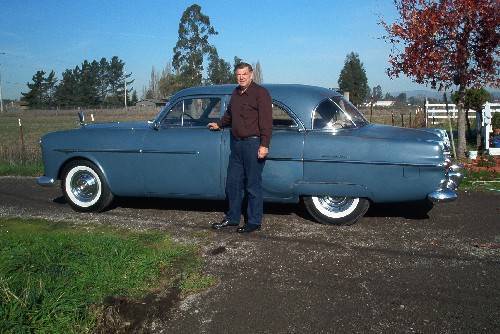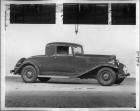|
Re: Let's discuss Packard 6V electrical systems and the change to 12V systems
|
||||
|---|---|---|---|---|
|
Home away from home

|
Wasn't Cosmoline that preservative that everything was covered with to ready a ship for mothballs? I'm not sure what Cosmoline has to do with battery voltage.
Bob
Posted on: 2008/6/21 23:18
|
|||
|
||||
|
Re: Let's discuss Packard 6V electrical systems and the change to 12V systems
|
||||
|---|---|---|---|---|
|
Home away from home

|
Looks like I should have read all the postings in this discussion befor I wrote the following but I'll leave it in anyway.
E= IR, IR Drop. The applied voltage has little to do with the voltage drop over the length of a wire. What is important is the I R drop. The loss along a wire is calculated by multiplying the current in amps times the resistance per foot in ohms. the result is the voltage drop per foot. Multiply the voltage drop per foot by the length in feet of the wire and you get the over all voltage loss. As the wire diameter goes up the resistance goes down and the voltage drop goes down. If you make the wire size smaller the resistance goes up and the voltage drop goes up. P=IE The power needed to turn the motor over with the starter motor doesn't change just because you changed the voltage. The power is the power. It is the measure of the mechanical force it takes to cause the motor to turn over fast enough to start. I is the current in amps and E is the voltage in volts. You can see that to develop the same power with 6 volts as opposed to 12 the current has to be twice as much. This necessitates the need for the larger wire size for 6 volt systems as opposed to 12 volt systems. I too think that the switch from 6 volt electrical systems to 12 volt systems was for economic reasons. With a 12 volt system all the wiring can be accomplished with much smaller wire including the internal wire of the starter and generator. Another note: I have owned dozens of cars with 6 volt systems in my day and had no particular problems. The voltage was not really an issue. If you maintain the engine in good condition as well as the battery and charging system you will never have a problem just because the battery has 3 cells instead of 6. Most of the starting problems are a result of low compression or starter problems or a poorly maintained charging system. The carburetor is a good place to look to correct a hard starting condition. Take care of it and it will take care of you. Bob
Posted on: 2008/6/21 13:28
|
|||
|
||||
|
Re: Repainting YOM lisence plates
|
||||
|---|---|---|---|---|
|
Home away from home

|
Thanks for the info. I'll try that.
Bob
Posted on: 2008/6/11 10:48
|
|||
|
||||
|
Re: Repainting YOM lisence plates
|
||||
|---|---|---|---|---|
|
Home away from home

|
Thanks for the information. I'm not far from Pleasanton. I'll call that guy.
I sure like this website. This is my first time talking with other people on what I think they refer to as a Blog. Bob
Posted on: 2008/6/10 12:56
|
|||
|
||||
|
Re: Oil Filter Lines
|
||||
|---|---|---|---|---|
|
Home away from home

|
I was looking at the pictures posted by Glenn. Maybe I'm butting in but it sure looks like the break peddle swing arm is brazed together. Not a good idea.
Posted on: 2008/6/10 0:39
|
|||
|
||||
|
Re: Oil Filter Lines
|
||||
|---|---|---|---|---|
|
Home away from home

|
Sorry to jump in here at this late date but I was looking at the pictures of the master cylinder modification you made and noticed what looks like a brazed joint in the swing arm. Was the arm cut and then brazed back together. If so I question the strength of the brass. Maybe it should have been welded. Wouldn't want to see all this good work go down the drain the first time you really need the brakes and the arm breaks off.
Posted on: 2008/6/9 23:02
|
|||
|
||||
|
Repainting YOM lisence plates
|
||||
|---|---|---|---|---|
|
Home away from home

|
Does anyone know the best way to restore/repaint your YOM plates? Is there someone in the San Francisco bay area that can do a nice job. I am reluctant to send them off. I'm afraid I wouldn't get them back.
Posted on: 2008/6/9 22:24
|
|||
|
||||
|
Re: Paint the characters on the back of the car red?
|
||||
|---|---|---|---|---|
|
Home away from home

|
Hi There, Yes the lettering on the trunk should be painted red. I have an origional one owner 1951, 300 that has never been touched and the lettering is red.
Posted on: 2008/6/1 17:43
|
|||
|
||||
|
Re: New Member - New Owner
|
||||
|---|---|---|---|---|
|
Home away from home

|
Hi,
I have a 51,300 that is still running on the original 6 volt positive ground system. I drive the car every day and have never had any trouble with it not starting or any other trouble with the electrical system at all. I've driven the car through the mountains to Reno and back in the dead of winter as well as in the summer with out a hint of trouble. I am a firm believer in leaving things the way the manufacturer intended them to be. Most all cars had 6 volt systems until the mid 50's. They all worked OK. I've had some 50 or more cars over the years and most of them were 6 volt cars and never had much thought about the battery voltage. I would fix what's wrong and leave it 6 volts and just enjoy it. Bob
Posted on: 2008/6/1 17:16
|
|||
|
||||

 (47.37 KB)
(47.37 KB)







